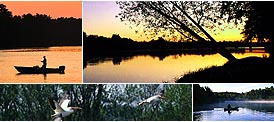
| Redfish | Sailfish | Sharks | Sheepshead | Snapper | Snook | Spanish Mackerel | Spotted Seatrout | Tarpon |

FLOUNDER
Regulations
No minimum size or closed season; 10 per person per day limit; may be harvested with a gig
General Information
This flat, bottom dwelling fish, represented in Florida by two species- the summer and southern flounder, is more common than many anglers think. The southern is larger of the two species. While anglers will catch most of these fish on the bottom, the fish is known to feed at all levels of the water column.
Distribution
The largest fish come from the northern part of Florida although good numbers of smaller fish are caught in the southern half of the state. The best places to find flounder are the passes, inlets, nearshore waters, and backwater bays close to the Atlantic or Gulf of Mexico. Peak season is in the fall.
Tackle
The traditional medium duty spinning or bait-casting rod and reel with 6-20 pound test line and a monofilament leader is more than sufficient for this species.
Bait
Small live finger mullet are the bait of choice along the Atlantic coast. Bull minnows are a favorite of upper Gulf coast anglers. Lures seldom generate strikes by flounder except for jigs tipped with shrimp and worked slowly along the bottom.
Secrets to Success
* The flounder's bite can be very subtle so you must be feeling for a gentle tapping. With time you can learn to distinguish the fish's bite to determine when to set the hook. Resist your temptation to set the hook as soon as you feel the bite. Let the fish take the bait and swim away with it. Count to 15 giving the fish time to swallow the bait, and then set the hook hard.












